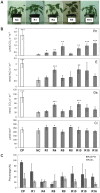A drought resistance-promoting microbiome is selected by root system under desert farming
- PMID: 23119032
- PMCID: PMC3485337
- DOI: 10.1371/journal.pone.0048479
A drought resistance-promoting microbiome is selected by root system under desert farming
Abstract
Background: Traditional agro-systems in arid areas are a bulwark for preserving soil stability and fertility, in the sight of "reverse desertification". Nevertheless, the impact of desert farming practices on the diversity and abundance of the plant associated microbiome is poorly characterized, including its functional role in supporting plant development under drought stress.
Methodology/principal findings: We assessed the structure of the microbiome associated to the drought-sensitive pepper plant (Capsicum annuum L.) cultivated in a traditional Egyptian farm, focusing on microbe contribution to a crucial ecosystem service, i.e. plant growth under water deficit. The root system was dissected by sampling root/soil with a different degree of association to the plant: the endosphere, the rhizosphere and the root surrounding soil that were compared to the uncultivated soil. Bacterial community structure and diversity, determined by using Denaturing Gradient Gel Electrophoresis, differed according to the microhabitat, indicating a selective pressure determined by the plant activity. Similarly, culturable bacteria genera showed different distribution in the three root system fractions. Bacillus spp. (68% of the isolates) were mainly recovered from the endosphere, while rhizosphere and the root surrounding soil fractions were dominated by Klebsiella spp. (61% and 44% respectively). Most of the isolates (95%) presented in vitro multiple plant growth promoting (PGP) activities and stress resistance capabilities, but their distribution was different among the root system fractions analyzed, with enhanced abilities for Bacillus and the rhizobacteria strains. We show that the C. annuum rhizosphere under desert farming enriched populations of PGP bacteria capable of enhancing plant photosynthetic activity and biomass synthesis (up to 40%) under drought stress.
Conclusions/significance: Crop cultivation provides critical ecosystem services in arid lands with the plant root system acting as a "resource island" able to attract and select microbial communities endowed with multiple PGP traits that sustain plant development under water limiting conditions.
Conflict of interest statement
Figures





References
-
- Bashan Y, Salazar BG, Moreno M, Lopez BR, Linderman RG (2012) Restoration of eroded soil in the Sonoran Desert with native leguminous trees using plant growth-promoting microorganisms and limited amounts of compost and water. J Environ Manage 102: 26–36. - PubMed
-
- FAO website. Available: http://www.fao.org/news/story/en/item/35571/icode/. Accessed 2012 May 15.
-
- Boyer JS, Westgate ME (2004) Grain yields with limited water. J Exp Bot 55: 2385–2394. - PubMed
-
- Gonzalez-Dugo V, Orgaz F, Fereres E (2007) Responses of pepper to deficit irrigation for paprika production. Sci Hortic 114: 77–82.
Publication types
MeSH terms
Substances
LinkOut - more resources
Full Text Sources
Other Literature Sources
Molecular Biology Databases
Miscellaneous

